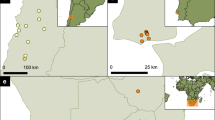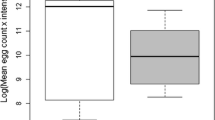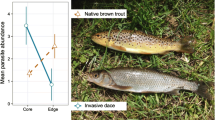Abstract
Successful establishment and spread of biological invaders may be promoted by the absence of population-regulating enemies such as pathogens, parasites or predators. This may come about when introduced taxa are missing enemies from their native habitats, or through immunity to enemies within invaded habitats. Here we provide field evidence that trematode parasites are absent in a highly invasive morph of the gastropod Melanoides tuberculata in Lake Malawi, and that the invasive morph is resistant to indigenous trematodes that castrate and induce gigantism in native M. tuberculata. Since helminth infections can strongly influence host population abundances in other host-parasite systems, this enemy release may have provided an advantage to the invasive morph in terms of reproductive capacity and survivorship.





Similar content being viewed by others
References
Abd el-Kader Saad AI, Abed GH (1995) Studies on the life cycle of Haplorchis pumilio (Looss, 1896) with morphological redescription of larval and adult stages. J Egypt Soc Parasitol 25:795–806
Albon SD, Stien A, Irvine RJ, Langvatn R, Ropstad E, Halvorsen O (2002) The role of parasites in the dynamics of a reindeer population. Proc R Soc B 269:1625–1632
Ballabeni P (1995) Parasite-induced gigantism in a snail: A host adaptation? Funct Ecol 9:887–893
Ben-Ami F, Heller J (2005) Spatial and temporal patterns of parthenogenesis and parasitism in the freshwater snail. Melanoides tuberculata. J Evol Biol 18:138–46
Byers JE, Goldwasser L (2001) Exposing the mechanism and timing of impact of nonindigenous species on native species. Ecology 82:1330–1343
Colautti RI, Ricciardi A, Grigorovich IA, MacIsaac HJ (2004) Is invasion success explained by the enemy release hypothesis? Ecol Lett 7:721–733
Dillon RT (2000) The ecology of freshwater molluscs. Cambridge University Press, Cambridge, United Kingdom
Dzikowski R, Levy MG, Poore MF, Flowers JR, Paperna I (2004) Use of rDNA polymorphism for identification of heterophyidae infecting freshwater fishes. Dis Aquat Org 59:35–41
Ebert D (1994) Virulence and local adaptations of a horizontally transmitted parasite. Science 265:1084–1086
Ebert D (1998) Experimental evolution of parasites. Science 282:1432–1435
Ebert D, Carius HJ, Little T, Decaestecker E (2004) The evolution of virulence: When parasites cause host castration and gigantism. Am Nat 164(Supp 5):S19–S32
Erpenbeck D, Breeuwer JAJ, van der Velde HC, van Soest RWM (2002) Unravelling host and symbiont phylogenies of halichondrid sponges (Demospongiae, Porifera) using a mitochondrial marker. Mar Biol 141:377–386
Evers BN, Madsen H, McKaye KM, Stauffer JR (2006) The schistosome intermediate host, Bulinus nyassanus, is a ‘preferred’ food for the cichlid fish, Trematocranus placodon, at Cape Maclear, Lake Malawi. Ann Trop Med Parasitol 100:75–85
Fredensborg BL, Mouritsen KN and Poulin R (2005) Impact of trematodes on host survival and population density in the intertidal gastropod Zeacumantus subcarinatus. Mar Ecol Prog Ser 290:109–117
Fromme AE, Dybdahl MF (2006) Resistance in introduced populations of a freshwater snail to native range parasites. J Evol Biol 19:1948–1955
Genner MJ, Michel E (2003) Fine-scale habitat associations of soft-sediment gastropods at Cape Maclear, Lake Malawi. J Molluscan Stud 69:325–328
Genner MJ, Michel E, Erpenbeck D, de Voogd N, Witte F, Pointier J-P (2004) Camouflaged invasion of Lake Malawi by an oriental gastropod. Mol Ecol 13:2135–2141
Genner MJ, Todd JA, Michel E, Erpenbeck D, Joyce DA, Jimoh A, Piechocki A, Pointier J-P (2007) Amassing diversity in an ancient lake: Evolution of a morphologically diverse parthenogenetic gastropod assemblage in Lake Malawi. Mol Ecol 16:517–530
Gérard C, Le Lannic J (2003) Establishment of a new host-parasite association between the introduced invasive species Potamopyrgus antipodarum (Smith) (Gastropoda, Prosobranchia, Hydrobiidae) and Sanguinicola sp. Plehn (Trematoda, Sanguinicolidae) in Europe. J Zool 261:213–216
Guindon S, Gascuel O (2003) A simple, fast, and accurate algorithm to estimate large phylogenies by maximum likelihood. Syst Biol 52:696–704
Heller J, Farstay V (1990) Sexual and parthenogenetic populations of the freshwater snail Melanoides tuberculata in Israel. Isr J Zool 37:75–87
Hudson PJ, Dobson AP, Newborn D (1998) Prevention of population cycles by parasite removal. Science 282:2256–2258
Keane RM, Crawley MJ (2002) Exotic plant invasions and the enemy release hypothesis. Trends Ecol Evol 17:164–170
Krakau M, Thieltges DW, Reise K (2006) Native parasites adopt introduced bivalves of the North Sea. Biol Invasions 8:919–926
Lively CM, Dybdahl MF (2000) Parasite adaptation to locally common host genotypes. Nature 405:679–681
Lively CM, Dybdahl MF, Jokela J, Osnas E, Delph LF (2004) Host sex and local adaptation by parasites in a snail-trematode interaction. Am Nat 164:S6–S18
Lo CT, Lee KM (1996) Pattern of emergence and the effects of temperature and light on the emergence and survival of heterophyid cercariae (Centrocestus formosanus and Haplorchis pumilio). J Parasitol 82:347–350
MacNeil C, Dick JTA, Hatcher MJ, Terry RS, Smith JE, Dunn AM (2003) Parasite-mediated predation between native and invasive amphipods. Proc R Soc London B 270:1309–1314
Mahdy OA, Shaheed IB (2001) Studies on metacercarial infection among Tilapia species in Egypt. Helminthologia 38:35–42
Minchella DJ (1985) Host life history variation in response to parasitism. Parasitology 90:205–216
Mouritsen KN, Jensen KT (1994) The enigma of gigantism: Effect of larval trematodes on growth, fecundity, egestion and locomotion in Hydrobia ulvae (Pennant) (Gastropoda: Prosobranchia). J Exp Mar Biol Ecol 181:53–66
Navajas M, Cotton D, Kreiter S, Gutierrez J (1992) Molecular approach in spider mites (Acari: Tetranychidae): preliminary data on ribosomal DNA sequences. Exp Appl Acarol 15:211–218
Newey S, Thirgood S (2004) Parasite-mediated reduction in fecundity of mountain hares. Proc R Soc London B 271:S413–S415
Prenter J, MacNeil C., Dick JTA, Dunn AM (2004) Roles of parasites in animal invasions. Trends Ecol Evol 19:385–390
Samadi S, Balzan C, Delay B, Pointier J-P (1997) Local distribution and abundance of thiarid snails in recently colonized rivers from the Caribbean area. Malacol Rev 30:45–52
Scholz T, Aguirre-Macedo ML, Salgado-Maldonado G (2001) Trematodes of the family Heterophyidae (Digenea) in Mexico: a review of species and new host and geographical records. J Nat Hist 35:1733–1772
Seeley RH (1986) Intense natural selection caused a rapid morphological transition in a living marine snail. Proc Nat Acad Sci USA 83:6897–6901
Sorensen RE, Minchella DJ (2001) Snail-trematode life history interactions: past trends and future directions. Parasitology 123:S3–S18
Sommerville C (1982) The life history of Haplorchis pumilio (Looss, 1896) from cultured tilapias. J Fish Dis 5:233–241
Strauss SY, Webb CO, Saamin N (2006) Exotic taxa less related to native species are more invasive. Proc Nat Acad Sci USA 103:5841–5845
Torchin ME, Lafferty KD, Dobson AP, McKenzie VJ, Kuris AM (2003) Introduced species and their missing parasites. Nature 421:628–630
Torchin ME, Byers JE, Todd C (2005) Differential parasitism of native and introduced snails: replacement of a parasite fauna. Biol Invasions 7:885–894
Umadevi K, Madhavi R (1997) Effects of light and temperature on the emergence of Haplorchis pumilio cercariae from the snail host, Thiara tuberculata. Acta Parasitol 42:12–17
Wang JJ, Chung LY, Lee JD, Chang EE, Chen ER, Chao D, Yen CM (2002) Haplorchis infections in intermediate hosts from a clonorchiasis endemic area in Meinung, Taiwan, Republic of China. J Helminthol 76:185–188
Acknowledgements
We thank the Department of Fisheries for support during our research programme. We also thank Alan Smith, Paul Nichols, Kate Jones and Tom Woolford for assistance surveying molluscs, Jan van Arkel for photography, and C. van Oosterhout and one anonymous reviewer for helpful comments. This work was primarily funded by European Commission Marie Curie Fellowship HPMF-CT-2000–79.
Author information
Authors and Affiliations
Corresponding author
Rights and permissions
About this article
Cite this article
Genner, M.J., Michel, E. & Todd, J.A. Resistance of an invasive gastropod to an indigenous trematode parasite in Lake Malawi. Biol Invasions 10, 41–49 (2008). https://doi.org/10.1007/s10530-007-9105-1
Received:
Accepted:
Published:
Issue Date:
DOI: https://doi.org/10.1007/s10530-007-9105-1




